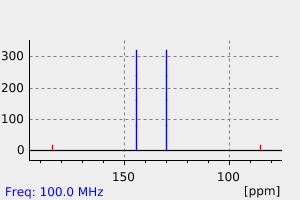4-methyl-4-nitrocyclohexa-2,5-dienone | 62622-59-7
分子结构分类
中文名称
——
中文别名
——
英文名称
4-methyl-4-nitrocyclohexa-2,5-dienone
英文别名
4-methyl-4-nitrocyclohexa-2,5-dien-1-one
CAS
62622-59-7
化学式
C7H7NO3
mdl
——
分子量
153.137
InChiKey
SKGFPCMAFZIZGL-UHFFFAOYSA-N
BEILSTEIN
——
EINECS
——
-
物化性质
-
计算性质
-
ADMET
-
安全信息
-
SDS
-
制备方法与用途
-
上下游信息
-
文献信息
-
表征谱图
-
同类化合物
-
相关功能分类
-
相关结构分类
物化性质
-
熔点:43-45 °C(Solv: methanol (67-56-1))
-
沸点:289.0±40.0 °C(Predicted)
-
密度:1.25±0.1 g/cm3(Predicted)
计算性质
-
辛醇/水分配系数(LogP):0.8
-
重原子数:11
-
可旋转键数:0
-
环数:1.0
-
sp3杂化的碳原子比例:0.29
-
拓扑面积:62.9
-
氢给体数:0
-
氢受体数:3
SDS
反应信息
-
作为反应物:描述:参考文献:名称:15 N核极化对硝基环己二酮重排机理的证据摘要:在未催化的和酸催化的4-甲基-4-硝基环六-2,5-二烯酮重排中均存在强15 N核极化,但在2-甲基-2-硝基环六-3,5-二烯酮的重排中不存在强15 N核极化。 。DOI:10.1039/c39880001195
-
作为产物:描述:参考文献:名称:Nitration studies of 4-substituted toluenes, 5-substituted hemimellitenes and acetoxyprehnitene摘要:报告了 报告了 4-甲氧基甲苯、4-溴甲苯和 4-乙酰氧基甲苯、5-氟甲苯和 5-乙酰氨基半甲苯以及乙酰氧基苯乙烯的硝化产物分布。 5-氟和 5-乙酰氨基半亚甲基苯,以及乙酰氧基麻黄烯的硝化产物分布。同位硝化的 Hammett 同位硝化的 p 值是通过与一系列 5-取代半亚甲基苯的竞争性硝化来估算的。 一系列 5-取代半亚甲基苯的竞争性硝化反应估算出同位硝化的 Hammett p 值。DOI:10.1071/ch9770113
文献信息
-
Formation of 4-Halo-4-nitrocyclohexa-2,5-dienones on nitration of p-halophenols and p-halophenyl acetates作者:Robin G. Clewley、Gordon G. Cross、Alfred Fischer、George N. HendersonDOI:10.1016/0040-4020(89)80128-0日期:1989.1Nitration of p-chloro-, p-fluoro-, and p-bromo-phenol or the corresponding p-halophenyl acetates at t-40 °C and below gives the 4-halo-4-nitrocyclohexa-2, 5-dienones in addition to the 4-halo-2-nitrophenols. The dienones isomerize to the nitrophenols at temperatures between −40 °C and 0°C. Nitration of 4-chloro-2-methylphenol or its acetate gives both 4-chloro-2-methyl-4-nitrocyclohexa-2, 5-dienone
-
ipso-Nitration: formation of nitronium acetate adducts in the nitration of p-acetamido-, p-halogeno-, and p-methoxy-toluenes, and α-p-tolyloxyisobutyric acid作者:Alfred Fischer、Deborah L. Fyles、George N. HendersonDOI:10.1039/c39800000513日期:——Low-temperature nitration of the title compounds in acetic anhydride gives 1,2 nitronium acetate adducts, except p-fluorotoluene which gives both 1,2 and 1,4 adducts and α-p-tolyloxyisobutyric acid which gives a spiro adduct.
-
The Reaction of Peroxynitrite with Organic Molecules Bearing a Biologically Important Functionality. The Multiplicity of Reaction Modes as Exemplified by Hydroxylation, Nitration, Nitrosation, Dealkylation, Oxygenation, and Oxidative Dimerization and Cleavage作者:Nobuaki Nonoyama、Hiroshi Oshima、Chizuru Shoda、Hitomi SuzukiDOI:10.1246/bcsj.74.2385日期:2001.12The reactions of peroxynitrite with a variety of organic molecules which include a biologically important functionality have been examined to construct a simple model for the peroxynitrite-induced in vivo transformations as well as a chemical probe for the active species involved therein. Phenols were found to undergo hydroxylation, nitration, oxidative dimerization, and oxidation to cyclohexadienones and quinones. The ring nitration of catechol was confirmed for the first time in the in vitro reaction of peroxynitrite. Dealkylation and N-oxide formation were the major reaction modes observed for N,N-dimethyl-p-toluidine. 1,2-Phenylenediamine gave benzotriazole in high yield. The electron-deficient C–C double bond in 1,4-naphthoquinone underwent epoxidation, while the electron-rich C–C double bond in α-methylstyrene suffered oxidative cleavage to acetophenone. The activated double bond in trans-stilbene underwent oxidative cleavage and epoxidation in parallel to give benzaldehyde and trans-stilbene oxide as the major products. The triple bond in diphenylacetylene was simply oxygenated to form benzil, together with trace amounts of ring nitration products. 1-Phenylethanol, imidazole, 2′-deoxyadenosine, and 2′-deoxyguanosine were all quite slow to react, while uracil and cytosine were almost inert to peroxynitrite. The reaction modes exhibited by peroxynitrite are too widespread and complicated to explain the whole mechanistic pathway in terms of a single active species. All reaction modes observed for the peroxynitrite to date could be classified into five categories according to their types: i) electron transfer type, ii) O-electrophilic type, iii) N-electrophilic type, iv) O-nucleophilic type, and v) radical type. Some of these may compete under certain conditions. The active species involved in each of these types of reactions are as follows: i) NO+, NO2, and OH, ii) ONOOH, iii) ONOOH and NO+, iv) OOH− and ONOO−, and v) NO2 and OH•.我们研究了过亚硝酸与多种有机分子的反应,这些有机分子具有重要的生物功能,我们通过研究这些有机分子的反应,为过亚硝酸诱导的体内转化建立了一个简单的模型,并为其中涉及的活性物种提供了一个化学探针。研究发现,酚类会发生羟化、硝化、氧化二聚化以及氧化成环己二烯酮和醌类。儿茶酚的环硝化首次在过亚硝酸盐的体外反应中得到证实。脱烷基化和 N-氧化物的形成是 N,N-二甲基对甲苯胺的主要反应模式。1,2-苯二胺能产生高产率的苯并三唑。1,4-萘醌中电子缺乏的 C-C 双键发生了环氧化反应,而 α-甲基苯乙烯中电子丰富的 C-C 双键发生了氧化裂解,生成苯乙酮。反式二苯乙烯中的活化双键同时发生氧化裂解和环氧化反应,生成的主要产物是苯甲醛和反式二苯乙烯氧化物。二苯基乙炔中的三键经过简单的氧合反应生成苯偶姻,以及微量的环硝化产物。1-苯乙醇、咪唑、2′-脱氧腺苷和 2′-脱氧鸟苷的反应速度都相当慢,而尿嘧啶和胞嘧啶对过亚硝酸几乎没有反应。亚硝酸过氧化物所表现出的反应模式过于广泛和复杂,无法用单一的活性物种来解释整个机理途径。迄今观察到的所有过氧化亚硝酸盐反应模式可按其类型分为五类:i) 电子转移型;ii) 亲 O 电型;iii) 亲 N 电型;iv) 亲 O 核型;v) 自由基型。在某些条件下,其中一些可能会发生竞争。这些类型的反应中涉及的活性物种如下:i) NO+、NO2 和 OH;ii) ONOOH;iii) ONOOH 和 NO+;iv) OOH- 和 ONOO-;v) 和 OH-。
-
Fisher, Alfred; Fyles, Deborah L.; Henderson, George, N., Canadian Journal of Chemistry, 1986, vol. 64, p. 1764 - 1770作者:Fisher, Alfred、Fyles, Deborah L.、Henderson, George, N.、Mahasay, Sumit RayDOI:——日期:——
-
Hartshorn, Michael P.; Judd, Maurice C.; Vannoort, Richard W., Australian Journal of Chemistry, 1989, vol. 42, # 5, p. 689 - 697作者:Hartshorn, Michael P.、Judd, Maurice C.、Vannoort, Richard W.、Wright, Graeme J.DOI:——日期:——
表征谱图
-
氢谱1HNMR
-
质谱MS
-
碳谱13CNMR
-
红外IR
-
拉曼Raman
-
峰位数据
-
峰位匹配
-
表征信息
同类化合物
顺式-2-硝基环己基乙酸酯
顺式-2-硝基-6-甲基环己酮
雷尼替丁杂质18
铝硝基甲烷三氯化物
钾离子载体III
重氮(硝基)甲烷
醛基-七聚乙二醇-叠氮
过氧亚甲基
辛腈,4-氟-4-硝基-7-羰基-
辛烷,1,2-二氯-1-硝基-
赤霉素A4+7(GA4:GA7=65:35)
苄哒唑
羟胺-四聚乙二醇-叠氮
羟胺-三乙二醇-叠氮
米索硝唑
磷酸十二醇酯
碘硝基甲烷
碘化e1,1-二甲基-4-羰基-3,5-二(3-苯基-2-亚丙烯基)哌啶正离子
硝酰胺
硝基脲银(I)复合物
硝基甲醇
硝基甲烷-d3
硝基甲烷-13C,d3
硝基甲烷-13C
硝基甲烷-(15)N
硝基甲烷
硝基甲基甲醇胺
硝基环辛烷
硝基环戊烷
硝基环戊基阴离子
硝基环庚烷
硝基环己烷锂盐
硝基环己烷钾盐
硝基环己烷
硝基环丁烷
硝基氨基甲酸
硝基新戊烷
硝基二乙醇胺
硝基乙醛缩二甲醇
硝基乙醛缩二乙醇
硝基乙腈
硝基乙烷-D5
硝基乙烷-1,1-d2
硝基乙烷
硝基乙烯
硝基丙烷
硝基丙二醛(E,E)-二肟
硝基丙二腈
硝基-(3-硝基-[4]吡啶基)-胺
硝乙醛肟







